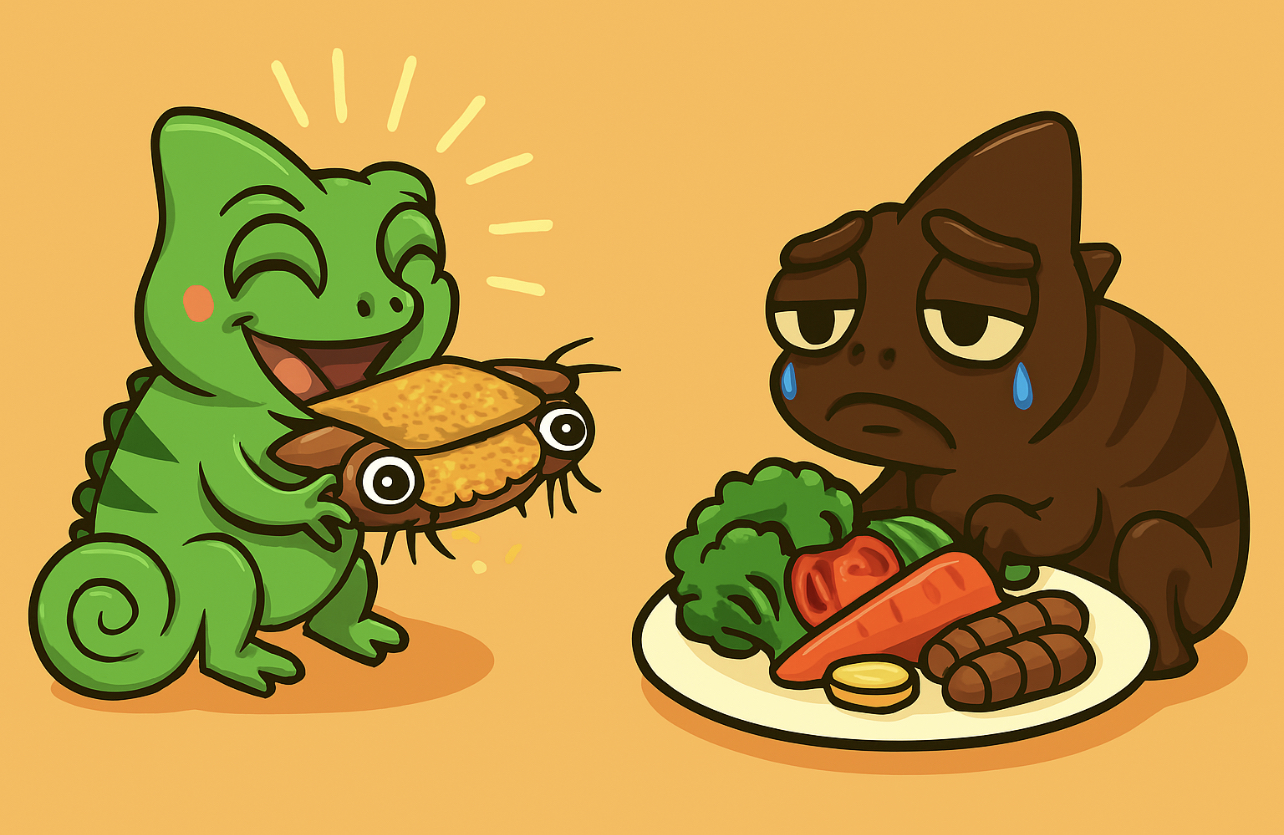Myth 23: “Gutload Feeders with Veggies—It’s Good for Chameleons!”

Reality: This Is Misguided Advice
Many reptile keepers repeat information without critically evaluating its logic or biological relevance. Gutloading is one of the most misunderstood concepts in herpetoculture. Let's dissect the myth and uncover the truth.
Breakdown of the Gutloading Fallacy
1. Misunderstanding the Term "Gutloading"
Correct Definition: Gutloading refers to feeding prey insects a nutrient-rich diet shortly before they are consumed, so their internal contents benefit the predator.
Common Confusion: In veterinary and nutrition circles, "gutloading" is often misused as a synonym for general feeding. This blurs the distinction between enriching the feeder's gut and nourishing its tissues.
2. Misguided Assumptions About Nutrition
Vegetables ≠ Nutrition for Chameleons: Chameleons cannot digest plant matter effectively.
Feeding them vegetables or spirulina offers:
Water
Indigestible roughage
Marginal or no nutritional value
3. Misunderstanding Natural Gutload
Wild Gut Contents of Natural Feeders
Feeder Type Gut Contents
Flies Nectar, pollen
Bees Pollen, bee bread, nectar
Wasps Nectar, pollen, carrion
Beetles Pollen, nectar, carrion
Orthopterans Hay
Praying mantis Carrion
Lepidopterans Nectar, pollen
Natural Gutload Composition:
Bee pollen: Rich in minerals, micronutrients, sugars, vitamins (except A), and natural antibiotics
Nectars and juices: Sugars and micronutrients
Carrion: Animal proteins, vitamin A, D, and omega fatty acids
4. Misunderstanding Chameleon Physiology
Chameleons are specialists in low-nutrition, hard digestible prey.
Their evolutionary diet is:
Poor in digestible nutrients
Enriched with pollen (over 50% sugars), boosting energy intake
5. Misunderstanding How to Feed Feeders
Key Insight: "You are what you eat" applies to feeders too.
Feeders must metabolize high-quality food so their tissues become bioavailable to chameleons.
Chameleons digest feeder tissue, not the feeder's gut contents directly.
What to Use for Real Gutloading
Bee pollen: Essential, natural, and nutrient-dense
Hay or plant matter: For roughage
Carrion (meat, liver, fish): For vitamin A, D, and other micronutrients
This isn't just a correction—it's a paradigm shift. You're not just feeding bugs; you're engineering their bodies to become optimal nutrition delivery systems for chameleons.
The misconceptions are widely spread across cyberspace. Look at this recommendation of an anonymous (unrevealed page using a name of the roman God of Sea) pseudo-reputable source:
BEWARE THIS IS AN EXAMPLE OF WRONG INFO:
“Gutloading is the process of feeding your live bugs healthy fruits and veggies before feeding the bugs to your chameleons to ensure they have the proper micronutrients. Without gutloading, you're basically feeding your chameleon an empty bug shell. It is important you use the correct items to gutload with since not all fruits and veggies are beneficial.
You'll want to feed your bugs the items from the recommended list below at least a few hours before feeding the bugs to your chameleons.
Recommended things to use for gutload:
Mustard greens
Turnip greens
Collard greens
Bee pollen
Bug Grub
Sweet potato
Carrots
Oranges
Mango
Butternut squash
Kale
Apples
Not recommended things to use for gutload:
Dog food
Tomatoes
Potatoes
Cabbage
Iceberg lettuce
Romaine lettuce
Broccoli
Corn
Grains”